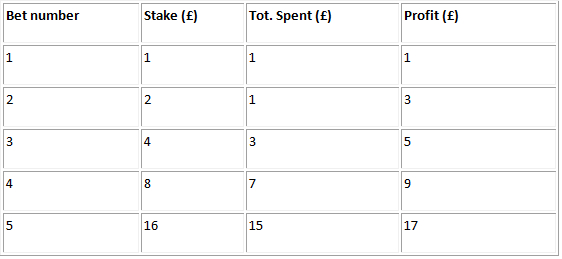Martingale and Anti-Martingale Trading Strategies
Martingale has to be one of the most popular and recognised gambling systems around, with the system dating back to the 18th Century. Many of the systems sold on sites such as eBay simply contain a basic martingale system with maybe one or two slight changes to spice things up a little.
Martingale is actually a very simple betting system. It involves placing a bet on a 50/50 event, and if the bet loses the stake from the original bet is doubled. Then if you lose again the bet is doubled once again, and so on and so forth. The idea is that when you do win, you will earn back more money then you have lost from all of your previous bets.
Martingale is most commonly used whilst playing the highly popular Roulette game. You would choose a colour, either red or black, and you would make a string of bets on one chosen colour. Every time you lose the bet, you have to double your stake. For example, if you start with £1 on red and the bet loses – your next bet will be £2 on red. If this loses again, your next bet will be £4 on red. This continues until (hopefully) you win your bet. You can see the earnings you would expect on the table below.
The Martingale system requires you to double your stake again when you lose. You bet four euros this time, and either win four euros or lose four euros. With a win of four and a previous loss of three, you can walk away with a win of one euro. With a loss of four, your total losses to date are seven euros, so your next bet is doubled up again, to eight euros. So it goes on.
Some people find it quite hard to spot the flaw in the Martingale system, and I admit I couldn’t really find a fault with the betting system at first. The one major problem is when you hit an “unlucky streak” and maybe have about 10 results that aren’t in your favour. Highly unlikely, but when it does happen it will wipe out your entire balance. Continuing the table on from above, if you went down to the 10th bet, you would be staking an amount of £512 to win around £500.
When using the Martingale system with trading it is highly likely that you will come across unlucky streaks of more then 10 consecutive losses, and so this is one of the main flaws of Martingale. Even if there were 10 or so “bad results”, you will still need to have a very large bankroll to be able to continue your pattern of doubling each bet that you make. This is the other main disadvantage of the Martingale system – you will need a very large amount of money to cover your bets for when you do have some bad results – and bad results are inevitable if you are going to be trading with this system.
Provided that you can afford to keep betting, it seems that you are certain to win, although as you can see you will only profit by one euro regardless of the size of your stake. The problem is that doubling your stake each time rapidly increases the amount of money you need, and a run of losses can easily put you in a position where you can’t afford to keep betting.
You can see that this is applicable to trading. If you lose with your first trade, why you simply double up your next trade and if you win you have covered your losses and made a profit. Of course you might lose again, and then you’d have to double up your trade again. As with betting on a roulette wheel, a run of losses can make the next trade impossible to afford, and the returns are limited.
Because of these problems, someone came up with the Anti-Martingale system, which is the exact opposite of the Martingale system. Instead of doubling your stake after a loser, you double it after a winner. The theory is that if you are on a winning streak, you might as well increase your stake and benefit.
If you analyze this for the roulette case, you will find that the last loser, with the largest bet, wipes out all the previous gains, so the system would only work with a “winning streak”. As a game of chance, statistically there is no such thing as a winning streak with roulette, and each spin of the wheel will give a random outcome.
However, this does not apply to trading. With trading, you would increase your investment in stocks that are winning. This is done in the hopes that the stocks will continue to rise, and as stocks are subject to trends rather than random fluctuations, this can be a winning strategy.
Having said that, it also means that your portfolio becomes biased towards stocks that have already increased value sharply. Simply because they have grown in value, it does not mean that they will continue to grow, but if they are growing with a strong trend then it can be a sound strategy.
Looks at overall, it may seem strange that two opposite systems, such as the Martingale and Anti-Martingale systems, can both be put forward as viable methods of making a profit. The fact is that they are not without faults, and each should be applied only in particular circumstances. If you try them out, make sure that you understand the advantages and disadvantages, and pick your trades with care. No system will allow you to profit without thought, and your time may be better spent improving your skills at technical analysis rather than playing around with Martingale theories.



Join the discussion